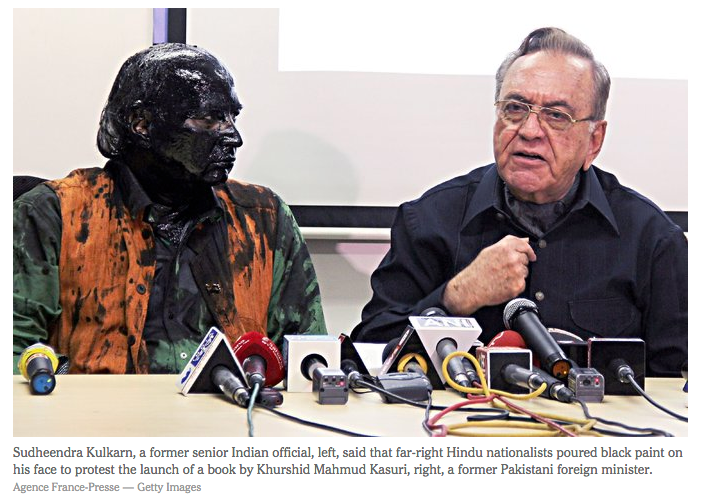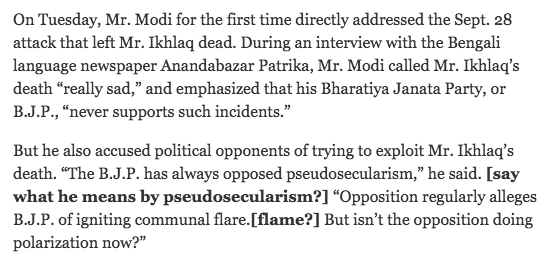Editorial square brackets
« previous post | next post »
 David Barstow and Suhasini Raj, "India Writers Return Awards to Protest Government Silence on Violence", NYT 10/17/2015:
David Barstow and Suhasini Raj, "India Writers Return Awards to Protest Government Silence on Violence", NYT 10/17/2015:
On Tuesday, Mr. Modi for the first time directly addressed the Sept. 28 attack that left Mr. Ikhlaq dead. During an interview with the Bengali language newspaper Anandabazar Patrika, Mr. Modi called Mr. Ikhlaq’s death “really sad,” and emphasized that his Bharatiya Janata Party, or B.J.P., “never supports such incidents.”
But he also accused political opponents of trying to exploit Mr. Ikhlaq’s death. “The B.J.P. has always opposed pseudosecularism,” he said. [say what he means by pseudosecularism?] “Opposition regularly alleges B.J.P. of igniting communal flare.[flame?] But isn’t the opposition doing polarization now?”
Presumably the boldface text in square brackets represents unanswered editorial interventions.
I sympathize, having more than once been co-author of a paper or a grant proposal in which such interventions were unintentionally retained.
The obligatory screenshot:

Victor Mair said,
October 17, 2015 @ 7:11 am
It's rather amazing that this level of sloppiness would occur at the NYT.
Still more amazing is when editors *intentionally* insert and leave square bracket comments or derogatory footnotes in a published work. Two examples of Sinological publications in which this happened:
=====
Tse-tsung Chow, ed., Wen-lin: Studies in the Chinese Humanities (Wisconsin: The University of Wisconsin Press, I968).
Joseph Needham, ed., Science and Civilisation in China (Cambridge University Press), an ongoing project of which there are many volumes.
=====
To avoid embarrassing them, I'm not mentioning the chapter / section authors who were thus victimized.
Ralph Hickok said,
October 17, 2015 @ 8:11 am
This looks to me like the result of a software "feature" that is really a bug.
In my pre-computer newspaper days, editorial questions such as these (the most common being "who he?" and "how here?) were written in the margins, so there was no chance of them being set in type.
I've done a lot of editing in MS Word, which also places comments in the margin. Evidently the software used by the NYT puts them in brackets within the text, which is obviously very dangerous.
Yuval said,
October 17, 2015 @ 9:35 am
They should have a popup warning when submitting a piece with a bold bracket of either face direction, like the one one gets when trying to send an empty email.
bks said,
October 17, 2015 @ 9:50 am
It can be seen as reassuring that the articles still undergo editorial review. So much of what passes for journalism on the web seems unedited.
Jerry Friedman said,
October 17, 2015 @ 10:07 am
Victor Mair: I don't see the editorial comments in your examples. Maybe the software swallowed them?
John said,
October 17, 2015 @ 10:09 am
@bks, apparently they're trying to make savings by only sending each article past an editor once…
Ben Zimmer said,
October 17, 2015 @ 10:47 am
Online edit captured by Newsdiffs.
Rachael said,
October 17, 2015 @ 11:41 am
I saw an example where a commenter thought this had happened and it hadn't. The text said something like "… according to a consumer magazine (Which?)" The commenter had apparently not heard of the magazine whose name is "Which?" and thought (Which?) was an editorial comment awaiting resolution.
Sili said,
October 17, 2015 @ 3:38 pm
Ralph Hickok,
That's just because you're not old enough. Plenty of classical and biblical trays have suffered emendation because the copyists couldn't tell marginal notes from corrections.
Ralph Hickok said,
October 17, 2015 @ 3:59 pm
Is anybody old enough? :)
Jason said,
October 17, 2015 @ 10:27 pm
Say, what does he mean by "pseudoscularism"
[(myl) https://www.google.com/search?site=&source=hp&q=pseudosecularism ]
Picky said,
October 18, 2015 @ 3:05 am
Sili
And even in Mr Hickok's time, given that corrections were also written in the margin, albeit with a caret or suchlike inside the line. Where there were comments and questions aplenty written in the margins, and a number of marks inside the line, errors were quite possible.
Sili said,
October 18, 2015 @ 6:16 am
"trays"?! Bloody phone! I probably means "texts". Sorry.
Ralph Hickok said,
October 18, 2015 @ 8:01 am
@Picky:
There's some truth in what you say, but there were at least three people checking everything that went into the paper to make it highly unlikely that such an error would occur. First, there was a proofreader who actually read proof–that is, compared the typeset matter to the original (edited) copy. Actual proofreading no longer exists because there's only one copy and nothing to compare it to.
Second, a galley proof came back to editorial to be checked. Third, once a page was made up, the makeup editor checked a page proof.
The procedure was similar in the book trade: Proofreading, galley proofs, page proofs, with both the author and an editor/proofreader checking the galleys and the page proofs.
That didn't totally eliminate errors, of course, especially under the pressure of deadlines, but it certainly came close. (The newspaper I last worked for, the New Bedford Standard-Times, once went 33 consecutive days without a single typo appearing in editorial matter, not even in the agate type used for school lunch menus.)
Picky said,
October 18, 2015 @ 1:32 pm
School lunch menus sounds riveting!
Your experience is in the opulent States, so I bow. Mine is in the indigent UK. My experience is that galley proofs came to the editor, to give him the opportunity to intervene (he certainly didn't proofread them all); to the subs if they'd requested; to subs if the readers had marked a query. Normal subs-to-reporters queries were dealt with long before typesetting.
Picky said,
October 18, 2015 @ 1:36 pm
Oh, and the rule with page proofs (except on the weekly paper where I started, and where time was slightly less of an essence) was to check heads, turns, intros and captions only.
Terrycollmann said,
October 24, 2015 @ 5:03 pm
The Indesign system used by a large number of newspapers allows editorial queries to be put in "Notes mode", which will not be reproduced in the printed version. I'm guessing the NYT doesn't use Indesign ….
Ralph Hickok – agate! Called ruby in Britain, don't know why. (5.5pt, to civilians)